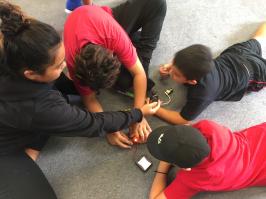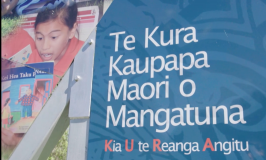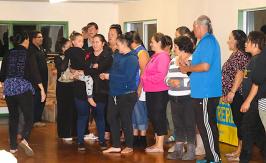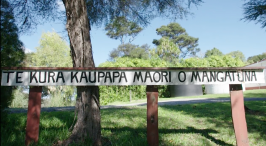Strengthening engagement with kura and whānau – a consultative approach

Facilitators from CORE Education, researchers, and four kura piloted a successful consultative approach to learning about digital technologies, with facilitation in te reo Māori. Their collaboration centred on raising the confidence and competence of kaiako in providing digital learning experiences with a Māori world view.
The project was an opportunity to strengthen engagement between kaiako, kura, and whānau. The consultative approach was very effective and could be used as a model for English-medium schools or consultants engaging with kura and iwi.
Schools may find aspects of this approach useful for engaging with their Māori community around the development of the digital technologies hangarau matihiko curriculum.
Strategies

Four strategies contributed to the effectiveness of the collaboration.
- Focusing on the kura context and philosophy by:
- aligning the programme to the special characteristics and strategic vision and purpose of the kura
- ensuring te ao Māori and te reo Māori were the foundation for all learning
- developing and applying hangarau matihiko platforms that gave expression to kura values, ancestral identities, and pūrākau
- creating space to discuss what “Māori digital fluency” means for the community, and how it can best be used as one platform to meet their learning aspirations
- engaging with kura communities in ways, times, and places that work best for them.
- Ensuring that sharing across kura is explicit by:
- creating systems where feedforward and feedback processes ensure learning is generative and collectively held, as opposed to transactional or the responsibility of a handful of kaiako.
- Creating hands-on activities for a variety of ages by:
- targeted and frequent exposure to hangarau matihiko resources to establish a foundation of hands-on activities for a range of ākonga (This is hindered by the limited number of reo and mātauranga platforms, but Hangarau matihiko affords opportunities for people of all ages to learn through play.)
- tailoring learning aims and content to students’ learning stages, interests, and strengths as they move through the curriculum and transition to tertiary learning or employment.
- A participatory and holistic approach
- While including a whole-of-whānau approach may be difficult for some kura, a focus on whānau, ākonga, and kaiako perspectives is positive. This approach aligns to the community-based philosophy of Māori-medium learning and can grow the digital awareness and capabilities of the whole community. Including whānau hui at the marae, with ākonga sharing their learning achievements, affirms a whole-of-whānau approach.
Approach

A team of ten from CORE Education Ltd worked with four kura on this project. The team’s experience included a knowledge of te reo Māori, Te Marautanga o Aotearoa (TMoA), the technology / hangarau learning area, the use of digital technologies and digital infrastructure, and educational research.
Hubs of expertise were created within the team and support and advice was given to the facilitators and the lead person working with each kura.
The team selected kura where they had existing working relationships. These were:
- Te Kura Kaupapa Māori o Māngātuna
- Te Kura Kaupapa Māori o Ngāti Kahungunu o Te Wairoa
- He Pua Mai i Rangiātea
- Te Kura Kaupapa Māori o Te Kura Whakapūmau.
Once kura agreed to participate in the project, an online webinar was arranged where kura, kaiako and ākonga, and whānau were able to discuss and explore digital technologies. This webinar was an opportunity for kura to communicate with each other. They discussed where they were currently positioned in terms of digital technologies and the future impact of technology on students proficient in te reo Maori.
Online webinars were a new experience for all four kura, and facilitators assisted in setting up and sorting out any technical difficulties. The webinar was followed by a face-to-face hui.
At the hui at Te Kura Kaupapa Māori o Māngātuna, students explored a robotic kit, using a te ao Māori perspective to learn, create, share, and explore design thinking. At an evening hui at the Hinemaurea marae ki Māngātuna, students demonstrated their digital technologies learning to whānau.
On-going support was offered through the Google blogsite and an online facility.
- See the CORE Education blogpost on the project.
Reflections

Research data was collected throughout the project to measure its effectiveness. The research findings indicate:
Extended knowledge and increased awareness
There was a shift in awareness of how digital technologies can support learning. For example, kaihuawaere observed that kaiako developed an increased understanding and awareness of emerging digital tools, such as coding and robotics, and the impacts of technology for their kura. Some ākonga sent letters of appreciation, expressing their enjoyment of the workshops and how they extended their understanding and knowledge of hangarau matihiko and te reo Māori.
As new concepts and elements of hangarau matihiko were introduced, kaiako and ākonga were able to identify opportunities for their learning and its application. Ākonga realised that hangarau matihiko was “more than just the internet”. They began to articulate new opportunities for their future study and employment.
Positive pedagogical shifts for kaiako
Kaiako were interested in the practical and play-based approaches that hangarau matihiko affords. They appreciated the chance to observe kaihuawaere implement strategies and techniques for teaching and learning hangarau matihiko in the classroom.
The involvement of ākonga and whānau in the programme will help to inform the long-term, strategic planning for the development of digital technologies in these kura.
Increased kaiako and whānau engagement and confidence
Increased exposure to hangarau matihiko experiences raised the confidence of kaiako. Providing these experiences with a Māori worldview, and with facilitation in te reo Māori, removed barriers to engagement.
The kura have begun to enlist support from the Connected Learning Advisory. Facilitators have supported kura to apply for professional learning and development to further develop their understanding of digital technologies within the technology/ hangarau learning area.
Whānau who engaged in the programme were interested in how hangarau matihiko can engage their tamariki in learning and in preparing for future employment. They were also eager to use kura networks to strengthen their reo Māori, identities, and culture.
Note that the programmes and/or resources used within this project are not officially endorsed by the Ministry of Education.
